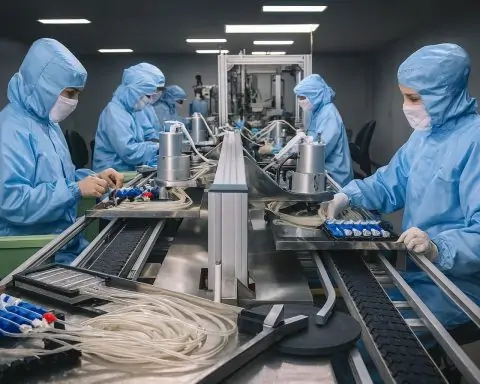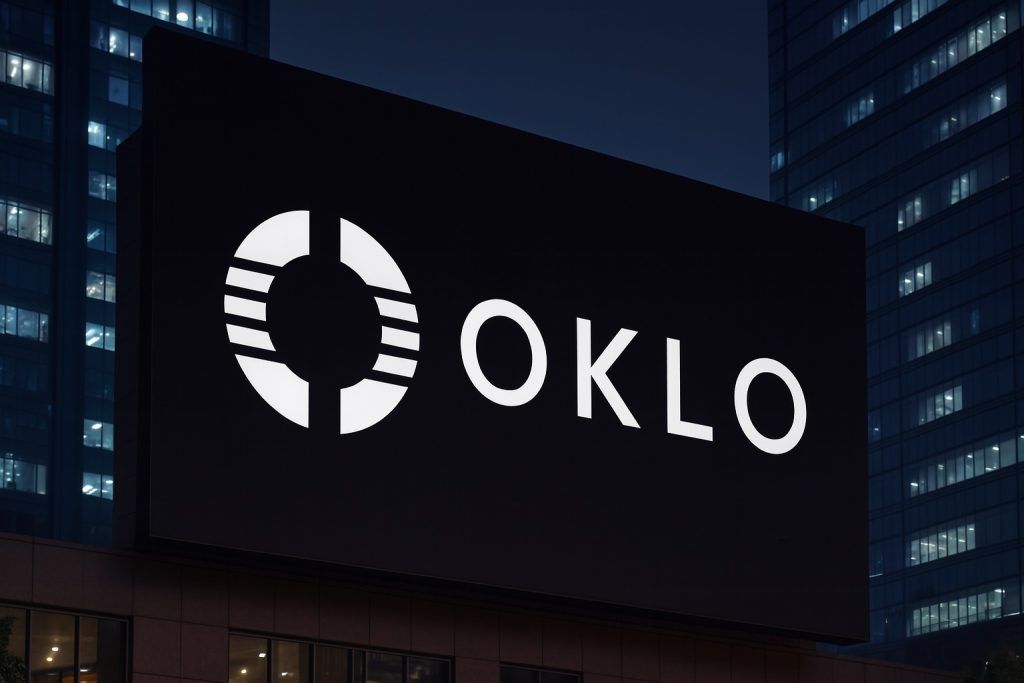- Tesla (TSLA) – EV leader with record deliveries (497,099 vehicles in Q3) and surging energy storage sales, leveraging AI hype despite margin pressures [1] [2]. Stock near ~$443 is priced well above analyst targets, reflecting big bets on self-driving and robotics ambitions [3].
- NextEra Energy (NEE) – World’s largest renewable utility hit a 52-week high (~$85) after an 18% one-month rally [4]. Steady ~6–8% earnings growth and a growing 29.5 GW clean power backlog underpin its premium valuation [5] [6], as AI data center power demand fuels investor optimism [7].
- First Solar (FSLR) – U.S. solar champion with a ~$229 share price [8], massive multi-year order backlog (~66 GW) [9], and booming profits (29% net margin) [10] thanks to IRA subsidies. Analysts are bullish (Jefferies’ target $260, JPMorgan $278) [11], seeing long-term upside from its tech edge and domestic manufacturing incentives.
- Plug Power (PLUG) – High-risk hydrogen play up 130% in six months [12] after H.C. Wainwright’s street-high $7 target (vs ~$3.50 market) [13]. Big news: a 10MW electrolyzer deployed for Europe’s largest green H₂ project [14] and record output at its U.S. hydrogen plant [15]. Rising electricity costs are making green hydrogen more competitive [16], but Plug still struggles with negative margins [17] – a speculative buy for believers in the hydrogen boom.
- Brookfield Renewable Partners (BEP) – A growth+income pick yielding ~5%. Shares (~$32) have rallied ~25% YTD on robust cash flow growth [18]. Backed by deep-pocketed Brookfield, it’s investing billions in wind, solar, hydro and even nuclear assets (e.g. Westinghouse stake) to ride a “once-in-a-generation” clean energy investment wave [19] [20]. Management projects >10% annual FFO/share growth through 2030 [21], supporting continued dividend hikes.
The Clean Energy Boom Powers Ahead
A renewable energy gold rush is underway. Global clean energy investment is on track to hit $2 trillion in 2024 – nearly double the spending on fossil fuels [22]. “A $23 trillion global market awaits us by 2030… a huge economic opportunity,” U.S. Energy Secretary Jennifer Granholm declared, underscoring the immense growth potential in green technologies [23]. Governments worldwide are pouring incentives into climate tech (from the U.S. Inflation Reduction Act’s $369 billion clean energy package to ambitious EU and China green targets [24]), spurring rapid expansion of solar, wind, electric vehicles (EVs), and hydrogen infrastructure. While market volatility and policy shifts can create short-term speed bumps, the long-term trajectory for renewables is up and to the right – a secular trend toward decarbonization that is reshaping the energy and automotive industries.
For investors, the challenge is picking the winners in this accelerating transition. Below, we spotlight five top clean energy stocks – each a leader in a different green subsector – that are “buys” right now. These companies offer a mix of high-growth innovation and stable cash-flow businesses, from EVs and solar panels to wind farms and hydrogen fuel cells. We examine their current performance (including latest stock prices as of Oct. 22, 2025), recent news, Wall Street forecasts, and the sector trends propelling their outlook. Whether you favor a growth play like a cutting-edge hydrogen startup or a value-oriented renewable utility, this basket covers the spectrum of green tech opportunities. Importantly, diversification across these picks can balance the higher-risk, high-reward names against steadier dividend-payers. Let’s dive into why each of these five stocks stands out in the clean energy boom of 2025.
1. Tesla (TSLA) – EV & Storage Trailblazer Fusing Cars, Batteries and AI
Subsector: Electric Vehicles & Battery Energy Storage (also solar energy systems)
Stock Price (Oct 22, 2025): ~$442.60 [25] per share (near all-time highs after a recent rally)
Latest Highlights: Tesla just posted record production and deliveries in Q3 2025 – delivering 497,099 vehicles (surpassing production) [26]. This bumper quarter was boosted by a short-term rush of buyers racing to beat an expiring $7,500 U.S. EV tax credit in September, which pulled demand forward [27]. Tesla also deployed a record 12.5 GWh of energy storage (Megapacks and Powerwalls) in the quarter [28], with booming demand from utilities and data centers hungry for battery backup. These records will propel Tesla’s revenue to an all-time high for Q3. However, profits aren’t keeping pace – Wall Street expects earnings around $0.54–0.55 per share, ~25% lower than a year ago [29]. Why? Tesla aggressively cut vehicle prices this year to stoke sales amid rising competition, slashing automotive gross margin to ~16–17% (less than half its 2021 peak) [30]. In short, Tesla is selling more cars but making less profit per unit.
Latest News: Investors are eagerly awaiting Tesla’s Q3 earnings call (scheduled for Oct. 22 after market). Key focus areas: profit margins, 2026 delivery guidance, and updates on new models like the next-gen Robotaxi platform. Elon Musk signaled Q3 would be “very bullish” – indeed, Tesla moved its shareholder meeting to early November, just after earnings, likely to tout the strong quarter to investors [31]. There’s also speculation Tesla will reveal more on its upcoming affordable model or progress in Full Self-Driving (Musk claims a driverless robotaxi network is on the horizon). Skeptics note Musk has overpromised on autonomy for years [32], but any concrete progress could further excite the market.
Meanwhile, Tesla’s energy division is emerging as a quiet powerhouse. The 12.5 GWh of battery storage deployed in Q3 is a company record [33], fueled by surging orders from big tech companies and utilities. As AI mega–data centers proliferate, their enormous power needs (and desire for reliable, green backup power) play right into Tesla’s battery business [34]. This helps diversify Tesla beyond car sales and provides higher-margin revenue to buffer the hit from auto price cuts.
Analyst Forecasts & Sentiment: Tesla’s stock has been on a tear in H2 2025 – up ~35% in the past 6 weeks – and recently traded around $440+, a level well above the average analyst price target (~$365) [35]. In fact, Tesla’s valuation is stretching into the stratosphere at ~85× earnings, which signals that investors are betting on future growth more than current fundamentals. “The stock’s value may depend less on these actual car sales and profit numbers and much more on investor belief in the company’s ambitious long-term plans for AI, self-driving cars, and robotics,” notes MarketPulse’s Zain Vawda [36]. Many on Wall Street remain cautious at these heights – of 42 analysts tracked by Yahoo Finance, fewer than 40% rate Tesla a Buy. The median price target has been creeping up but still implies only mid-single-digit upside. Bulls, however, argue that Tesla’s lead in EV technology, its expanding energy storage segment, and potential breakthroughs in AI (like its Dojo supercomputer and full self-driving software) warrant a premium. Notably, Tesla is one of the “Magnificent 7” mega-cap tech stocks leading the market and enjoys outsized retail investor enthusiasm.
Growth vs. Value, Short vs. Long Term:Short-term (next 6–12 months), Tesla’s stock could be volatile. Price cuts are boosting volume but squeezing profits; any sign of demand softening (especially after the tax credit pull-forward) or further margin erosion could spur a pullback. Additionally, a controversial $1 trillion performance award for Musk is up for shareholder vote – proxy advisors call it “astronomical” [37] – introducing governance drama that could weigh on sentiment. That said, Tesla’s long-term outlook remains electrifying. It still targets 20 million vehicle deliveries by 2030 (an almost 15× increase from ~1.3 million in 2022), which would require both introducing cheaper models for mass-market adoption and scaling production in new gigafactories. If autonomy or its humanoid Optimus robots yield a commercial breakthrough, Tesla could tap entirely new profit pools in transport-as-a-service or robotics. Musk himself insists Tesla will be as much an AI company as an automaker. For long-term investors who can stomach volatility, Tesla offers a unique blend of clean tech and high-tech – essentially an EV/battery manufacturer plus a tech moonshot (AI, software, robotics) under one roof. It’s undoubtedly priced for perfection, but with execution, Tesla could justify its valuation over a multi-year horizon. In contrast to staid utilities or yield plays, Tesla is the high-growth engine of a green portfolio – a bet on innovation and market disruption. Just be prepared for twists and turns on the road ahead.
2. NextEra Energy (NEE) – Renewable Utility Powerhouse with Steady Growth
Subsector: Renewable Power Generation (Wind & Solar Farms, Energy Storage; plus Regulated Electric Utility)
Stock Price (Oct 22, 2025): ~$84 (near one-year high) [38] [39]; market cap ~$170 billion.
Overview: NextEra Energy is often called the “Exxon of Green Energy.” It is the world’s largest producer of wind and solar power, primarily via its NextEra Energy Resources arm, and also operates Florida Power & Light (FPL), a major electric utility. Unlike Tesla, NextEra is a more traditional company – profitable, paying dividends, and growing steadily in the mid-single digits. But it’s far from boring: NextEra has aggressively expanded its renewables portfolio for decades, giving it a first-mover advantage that rivals find hard to match. In Q2 2025, NextEra’s adjusted earnings rose ~9% and it reaffirmed its long-term growth guidance of 6%–8% EPS expansion annually through 2027 [40] [41]. It also reported a record renewables project backlog of 29.5 GW – larger than the total installed solar capacity of most countries – signaling robust future construction [42] [43]. This pipeline includes wind farms, solar installations, and battery projects across North America, often under long-term contracts. Such scale and visibility are why NextEra’s stock tends to command a premium valuation relative to other utilities.
Recent Performance: The past month has been strong for NEE. Through Oct 10, NextEra surged 18% in just four weeks, vastly outperforming the S&P 500 [44]. The stock recently notched a new 52-week high around $86 [45]. This rebound comes after a choppy period – recall that in late 2023, NextEra’s shares were hit hard when its yieldco affiliate faced financing challenges amid rising interest rates. In 2024, NEE lagged the market for a while. But sentiment has shifted positive as inflation and rates showed signs of stabilizing and as NextEra continued to deliver solid earnings. Some observers also tie NextEra’s rally to the AI computing boom: massive data centers require huge amounts of electricity, boosting demand for utility-scale renewable projects [46] [47]. In other words, even with a fossil-fuel-friendly administration in Washington, market forces (like AI and corporate ESG goals) are driving investment in clean power. NextEra, with its scale and expertise, is capturing a good chunk of that business.
Latest News: NextEra is due to report Q3 2025 earnings in late October. Zacks forecasts ~8% EPS growth for the quarter, and early indications are that results will be in line with the company’s long-term trajectory [48]. Analysts have noted that NextEra’s story is “evolving” but remains compelling – its regulated utility FPL provides stable cash flow (from ~12 million Florida customers), while the Energy Resources unit provides growth by signing new wind/solar contracts across the continent [49]. One watch item is interest rates: as a capital-intensive utility, NextEra’s financing costs and stock valuation are sensitive to bond yields. The recent run-up (18% in a month) may partly reflect easing rate fears. Indeed, Jefferies just raised its price target on NEE to $85 (Hold) [50], essentially acknowledging the stock’s upward move but suggesting limited near-term upside from here. Barclays also boosted its target, citing NextEra’s strong execution on renewables and improving sentiment after the sell-off [51]. On the flip side, some critics argue NextEra’s growth will slow if policy support wanes under the current U.S. administration, which has emphasized fossil fuels. Notably, President Trump’s return to office in 2025 introduced some uncertainty (e.g. possible rollbacks of climate regulations), but so far NextEra’s development plans appear largely undeterred – its projects often span 20–30 years and are driven by economics (the falling cost of wind/solar) and state-level mandates, which remain favorable.
Analyst & Investor View: NextEra is widely held by both growth and income investors as a quintessential “green chip” stock. It offers a dividend (currently yielding ~2.5%) that has grown ~10% annually over the past 5 years. Management indicated it intends to continue ~10% dividend growth through at least 2024, supported by earnings expansion and a payout ratio in the ~60% range. This makes NEE attractive for those seeking reliable income plus growth – a rare combo. The stock’s valuation – about 20× forward earnings – is richer than a typical utility (~14×) [52], reflecting NextEra’s superior growth rate and clean energy focus. As Morningstar put it, investors assign a “renewables premium” to NEE. The consensus rating is “Buy”, though some analysts have trimmed views after the recent rally (worried it might be “overvalued after an 18% one-month surge” as one Motley Fool piece questioned). Still, with its scale, NextEra enjoys cost advantages and regulatory know-how that give it a wide moat in renewables.
Growth vs. Value Outlook:Short-term, NextEra’s stock may take a breather after its rapid climb – much of the good news (earnings resilience, backlog growth) is priced in around the mid-$80s. Any disappointments (e.g. if Q3 earnings or 2026 guidance come in light) could trigger a pullback. Additionally, if interest rates spike again or if there’s political noise (say, unfavorable policy changes), yield-sensitive utility stocks would feel pressure. However, long-term, NextEra remains one of the safest and most compelling clean energy investments. The world’s push toward decarbonization is a multi-decade trend, and NextEra is positioned to benefit as a leading developer and operator of renewables infrastructure. It provides a more stable, value-oriented counterweight to high-volatility names in a green portfolio. You get the stability of a regulated utility and the upside of a renewable developer under one umbrella. In essence, NextEra is to renewable energy what a blue-chip is to tech – you might not get explosive returns, but you’re likely to get consistent growth and income. For investors seeking to capitalize on clean energy with lower risk, NEE remains a top pick, blending the virtues of innovation and infrastructure in the energy sector.
3. First Solar (FSLR) – Solar Manufacturing Leader Riding Policy Tailwinds
Subsector: Solar Energy – Photovoltaic (PV) Module Manufacturing
Stock Price (Oct 22, 2025): ~$229 [53] per share; market cap ~$25 billion.
Why It’s a Top Pick: First Solar is the largest U.S.-based solar panel manufacturer and a global leader in advanced thin-film PV technology. If NextEra is building the solar farms, First Solar is often supplying the panels. The company’s cadmium telluride (CdTe) panels are prized for their durability and strong performance in hot, humid climates (they can outperform conventional silicon panels in such conditions). First Solar is essentially sold out for years – its order backlog at Q1 2025 was a staggering 66.1 GW of future deliveries [54], extending into 2029. This demand is fueled by worldwide solar adoption and big incentives for domestic solar manufacturing in the U.S. (courtesy of the Inflation Reduction Act). In 2024, First Solar’s revenues jumped to $4.2 billion (from $3.3 B in 2023) with hefty profits – an FY2024 net income of $12.02 per share [55]. The company raised capacity and benefited from a lucrative IRA manufacturing credit (45X) that essentially pays it 0.17 ¢ per watt produced in the U.S., bolstering margins. For 2025, First Solar initially guided an even more eye-popping $17–20 EPS [56], but it revised that down to about $13.5–16.5 due to some evolving market factors (more on that below) [57]. Even at the low end, First Solar trades at ~17× forward earnings – a reasonable multiple for a 20%+ long-term EPS grower with huge visibility.
Latest Company News: On the technology front, First Solar made headlines by licensing out some of its next-gen TOPCon solar cell patents to a startup (Talon PV) aiming to build a 4 GW factory in the U.S. [58]. It also filed suit against Chinese rival JinkoSolar for patent infringement on that same tech [59] – showing First Solar’s increasing influence beyond its own thin-film niche (it acquired these silicon PV patents years ago and is now monetizing them). These moves suggest FSLR could earn royalty income down the road, and they underscore its role in protecting U.S. solar IP.
The more pressing news has been trade policy. In early 2025, the new Trump administration set in motion hefty tariffs (up to 254%) on imported solar panels from Southeast Asia, targeting Chinese manufacturers skirting existing duties [60]. Ironically, this affected First Solar in two ways. Positively, it makes competing panels more expensive, essentially locking in First Solar’s pricing power and market share in the U.S. for years. The company noted the “trade environment continues to be overall long-term favorable” for them [61]. But negatively, First Solar itself produces panels in Vietnam and Malaysia (for U.S. import) and in India. Those overseas factories got caught in the tariff net since the new rules didn’t exempt U.S. companies’ foreign-made panels. In response, First Solar trimmed its 2025 sales and production guidance – expecting to ship fewer modules from Asia to America and possibly idle some overseas lines if tariffs persist [62] [63]. It plans to pivot more output to the Indian market from its India plant, and rely on its expanding U.S. factories (Ohio and a new Alabama plant coming online) to serve America [64]. Bottom line: near-term revenue will be a bit lower than initially thought (hence the guidance trim), but because tariffs also cripple many foreign competitors, First Solar may actually emerge even stronger domestically, selling every module it can make in the U.S. at attractive margins. The stock initially dipped on the guidance revision in April, then rebounded as investors digested that the U.S. solar market remains on fire and First Solar faces more demand than it can fulfill. Indeed, the stock is up ~24% in 2025 so far [65], and multiple analysts have raised price targets through the year.
Analyst Forecasts & Ratings: Wall Street is broadly bullish on FSLR. In October, JPMorgan boosted its target from $262 to $278 (Overweight) and Jefferies from $212 to $260 (Buy) [66], citing strong policy support and First Solar’s expanding manufacturing capacity. The consensus of 30+ analysts is around $242/share [67], just above the current price – but that consensus has steadily risen, and many top solar analysts have targets in the high-$200s. There are a few Hold ratings (and one lone Sell) given the run-up in price, but importantly, First Solar now has earnings to back up its valuation – a P/E around 19 [68], which is actually cheaper than the broad market. The company’s balance sheet is another strength: it ended last quarter with ~$2 billion net cash, providing funds for new factories and R&D while many solar peers are debt-laden. Insiders, including the CEO Mark Widmar, sold some shares in mid-2025 around $180 (likely as pre-planned trades) [69], but that was well below today’s price, and insiders still hold significant stakes. Institutions own over 90% of the float [70], including many ESG funds and climate-focused investors who see First Solar as a core long-term holding.
Short vs. Long-Term Outlook:Short-term (next ~1 year), First Solar’s growth is largely baked in – production is ramping, and revenue will jump as new factories come online and backlog orders are fulfilled. Investors should watch how the tariff situation evolves: there’s a 90-day pause on some Trump tariffs [71] as of Q2, and it’s unclear if a compromise will emerge. If tariffs stick, First Solar might sacrifice some low-margin sales from its Asia plants (not a big loss financially) but could benefit from less competition. Another short-term factor is the price of polysilicon (for silicon panels) – it crashed in 2023, which lowered solar panel prices industry-wide in 2024. If global panel prices rebound in 2025, First Solar could potentially raise its prices or see fatter margins. The company already expects a “meaningful adverse margin impact” on U.S.-bound panels from its Asian plants if tariffs fully apply [72] – but again, it can likely offset that by charging more, since U.S. buyers have few other choices for tariff-free panels. Long-term, First Solar’s prospects look brilliant. Solar is projected to be the fastest-growing energy source worldwide for the next decade. First Solar is expanding capacity to ~21 GW by 2026 across Ohio, Alabama, India, etc., and it continues to innovate in efficiency. Its CdTe technology got a boost with a recent efficiency record, closing the gap with silicon cells. Plus, the U.S. policy support is locked in for years: the IRA manufacturing credits run through at least 2030, essentially subsidizing First Solar’s costs to the tune of hundreds of millions per year (the company got ~$1.9 billion in anticipated IRA credits net present value from Q4 2024 alone [73]). This allows FSLR to both invest in growth and maintain solid profitability. By 2030, management envisions compound annual growth >15% in revenue, with potential EPS in the $30+ range if all goes well – meaning the stock, at $229, is still reasonably valued for that trajectory.
In sum, First Solar is a clean energy “picks and shovels” play – instead of selling electricity or cars, it sells the critical equipment enabling the solar revolution. It offers a compelling balance of growth and quality: unlike many renewable startups, FSLR is profitable and well-capitalized, yet it can still grow earnings at double-digit rates under favorable conditions. Risks include tech competition (Chinese manufacturers aren’t standing still) and policy flip-flops, but FSLR’s strong moat (patents, scale, bankability) and the global rush to solar make it one of the best-positioned solar stocks. It suits investors looking for a pure-play on the solar boom, with a medium-to-long term investment horizon. Expect some volatility with trade news and quarterly bookings numbers, but over the long run, First Solar could shine even brighter as solar becomes the “new king of electricity markets” (to quote the IEA’s Fatih Birol [74]).
4. Plug Power (PLUG) – Speculative Hydrogen Power Play With Breakout Potential
Subsector: Hydrogen Fuel Cells & Electrolyzers (Green Hydrogen Production and Fuel Cell Systems)
Stock Price (Oct 22, 2025): ~$3.40 per share (small-cap territory, ~$2 billion market cap)
The Story: Plug Power is a high-risk, high-reward bet on the hydrogen economy. The company is a leading provider of PEM fuel cells (used in forklifts, warehouse equipment, and stationary backup power) and electrolyzers (machines that produce hydrogen fuel from water using electricity). In essence, Plug’s vision is an end-to-end green hydrogen ecosystem: use renewable electricity to produce green hydrogen, then use that hydrogen in fuel cells to power vehicles and industry, replacing fossil fuels. This concept has massive long-term appeal in decarbonizing hard-to-electrify sectors (like long-haul trucking, heavy industry, and round-the-clock power generation). However, building it has been a long, cash-burning journey – Plug Power was founded in 1997 and has yet to turn an annual profit. The stock skyrocketed during the 2020–2021 clean tech bubble (briefly peaking above $70), only to crash over 90% as hydrogen hype cooled and execution lagged. Now, in late 2025, Plug shares trade under $4, making it essentially a call option on green hydrogen’s future.
Recent Momentum: Intriguingly, Plug’s stock has shown signs of life in recent months. It has climbed over 130% in the past six months [75] (albeit from a very low base – roughly $1.50 in early spring to ~$3.50 now). The catalyst? A notable endorsement from Wall Street: in August and October, H.C. Wainwright – a research firm bullish on hydrogen – raised its price target on PLUG from $3 to $7, with a Buy rating [76]. $7 is the highest target on the Street and implies that Plug could double from current levels. Wainwright’s thesis is that macro trends are turning in Plug’s favor. They noted that electricity prices are rising in many regions (U.S. power rates up ~5–6% YoY on average, with some states like Maine +36% [77]), which ironically helps green hydrogen. Why? Because conventional grey hydrogen (made from natural gas) becomes pricier if electricity and gas costs rise, making green hydrogen produced from renewables more competitive [78]. Moreover, there’s growing support for nuclear-powered hydrogen (using electricity from small modular reactors to make H₂), with big federal targets for new nuclear capacity [79] – potentially another source of cheap, carbon-free power for hydrogen. In short, Wainwright sees a landscape where green hydrogen’s economics steadily improve, boosting demand for Plug’s equipment.
Latest News & Deals: On the ground, Plug Power has scored some tangible wins: it delivered its first 10 MW electrolyzer array to Galp in Portugal [80], which will become Europe’s largest green hydrogen plant. Once operational by 2026, that project will churn out 15,000 tons of H₂ annually [81] – a great case study (and reference site) for Plug’s tech on a big stage. Plug also hit a production milestone at its own U.S. green hydrogen plant in Georgia, making 324 metric tons of liquid hydrogen in August [82] (roughly equivalent to fueling 1,000 fuel-cell forklifts for a month). This shows Plug is improving execution on the production side, not just selling hardware. On the customer front, Plug’s core material handling business (fuel-cell systems for forklifts) continues to grow with marquee clients like Amazon, Walmart, and Home Depot using its GenDrive units in distribution centers.
However, challenges persist: Plug’s profitability is deeply negative, with gross margins still below zero [83] as it ramps new product lines. It has been burning over $100 million per quarter in cash. To fund operations, Plug recently amended an at-the-market (ATM) share offering to raise up to $1 billion [84] – essentially diluting shareholders to get more cash. This move was not warmly received by the market, but it’s a lifeline for Plug to execute its plans (the company aims to hit $1.4 B in revenue this year and around $4 B by 2027, with positive operating cash flow by 2026 – ambitious targets that skeptics doubt).
Analyst Sentiment: Wall Street is sharply divided on Plug. On one end, you have bulls like Wainwright ($7 target) and Craig-Hallum, which also reiterated a Buy and raised its target to $4 after meeting with Plug’s CFO (citing “a positive growth outlook” and operational improvements) [85]. On the other end, major banks are bearish: Morgan Stanley recently reiterated Underweight with a $1.50 target, essentially predicting another collapse [86]. Even the average analyst target (around $3) is slightly below the current price [87], and the consensus rating is Hold [88] – reflecting uncertainty. The stock is heavily shorted as well, as many traders bet that Plug will fumble or that hydrogen’s promise will remain distant. Short interest is reportedly over 20% of float, which means any positive news (like policy support or big contracts) can trigger outsized rallies as shorts cover – contributing to the volatility.
Investment Outlook:Short-term, Plug Power is a volatile trade. It can swing wildly on news such as quarterly earnings (where revenue growth and margin trajectory will be scrutinized) or government announcements. For instance, if the Department of Energy awards grants or if a state like California signs a big green hydrogen deal, Plug’s stock could spike. Conversely, any delay in reaching cash-flow breakeven or further dilution could sink it. Essentially, don’t invest in PLUG money you can’t afford to lose – it’s speculative. Long-term (3–5+ years), the upside scenario is enormous: if green hydrogen becomes a cornerstone of global energy (as many net-zero plans require by 2030–2040), Plug could transform from a penny stock into a renewable energy giant. It has a first-mover advantage in key niches (over 60,000 fuel cell units deployed, leading market share in electrolyzers) and strategic partnerships worldwide. The U.S. IRA offers production tax credits (up to $3 per kg of green hydrogen) which began in 2023 and scale up projects starting now – Plug itself is building multiple hydrogen plants to capitalize on that. Europe and Asia are also investing in H₂ hubs. If Plug can execute – raising enough capital to scale, improving its technology and manufacturing efficiency to turn margins positive – it could ride the hydrogen boom and reward bold investors with multi-bagger returns from today’s levels.
That said, the downside scenario is that hydrogen adoption stays slower than expected (due to high costs or competing tech like improved batteries), and Plug can’t stop bleeding cash, eventually forcing a sale or significant restructuring. It’s a classic “story stock”: tremendous narrative, but a need to prove itself financially. In a diversified portfolio, PLUG belongs in the high-growth speculative bucket – perhaps paired with steadier picks like NextEra or Brookfield to balance risk. As an aggressive bet on the future of clean energy, Plug Power offers potentially explosive gains if the green hydrogen revolution materializes – making it a compelling, if speculative, inclusion among the best green energy stocks to buy now.
5. Brookfield Renewable Partners (BEP/BEPC) – Global Clean Energy Operator Blending Growth and Yield
Subsector: Renewable Infrastructure (Hydroelectric, Wind & Solar Farms, Energy Storage; plus emerging technologies)
Stock Price (Oct 22, 2025): ~$33 (BEP units, NYSE) / ~$40 (BEPC shares) – they represent the same business [89]; market cap ~$11 billion (excluding debt).
Dividend Yield: ~4.5% (quarterly distribution of ~$0.3375 per unit).
Business Snapshot: Brookfield Renewable is one of the world’s largest publicly traded pure-play renewable power platforms. It’s the renewable arm of Brookfield Asset Management, a global asset manager. Via Brookfield Renewable, it owns and operates a diverse portfolio of clean energy assets: over 25 gigawatts of capacity across hydroelectric dams, wind farms (onshore and offshore), utility-scale solar, distributed solar (rooftop/industrial), and energy storage. It operates in North America, South America, Europe, and Asia. Crucially, Brookfield has a long track record (over 20 years) of acquiring and optimizing renewable assets, often through partnerships and joint ventures. This company is essentially the “buy and hold” clean energy investor for you – it buys or develops projects, signs long-term power contracts, and generates steady cash flows, a big chunk of which it returns to investors as dividends. At the same time, it recycles capital into new projects to grow. This makes Brookfield Renewable a balanced play: you get a solid dividend and growth potential as the renewable fleet expands.
Recent Performance & Growth Plans: 2025 has been a good year for Brookfield Renewable’s stock. Units are up roughly 25% year-to-date and ~10% year-over-year [90], reflecting improved market sentiment after a tougher 2022–23 when rising interest rates pressured yield-oriented stocks. The partnership’s cash generation is accelerating: in Q2 2025, Brookfield Renewable posted nearly $1.7 B in revenue and double-digit growth in Funds From Operations (FFO) – a key metric for profitability in this sector [91]. Management reaffirmed a more than 10% annual FFO per share growth target through 2030 [92], driven by a combination of new project commissions, margin improvements, and inflation-linked escalators in many contracts. In fact, CEO Connor Teskey has said they expect to double the business roughly every 5–7 years given the pipeline of opportunities. To fuel that, Brookfield has significant capital backing: it raised a dedicated $20 billion “Global Transition Fund II” in 2025 (one of the largest climate-focused funds ever) to co-invest alongside Brookfield Renewable in decarbonization projects [93]. This war chest means Brookfield can go after large deals that others might shy away from.
And Brookfield has been very active in 2025. For example, it acquired a 1.74 GW solar and wind development portfolio (National Grid Renewables) for $1.74 B [94], expanding its U.S. pipeline. It also agreed in October to buy out the remaining stake in its nuclear services venture (Westinghouse), betting on nuclear power’s role in the energy transition (Brookfield sees synergies with providing zero-carbon baseload power to complement wind/solar). Further, Brookfield is investing $1 billion to boost its stake in Isagen, a Colombian renewable utility, to 38% [95] [96] – increasing exposure to high-growth emerging markets. On the development side, Brookfield has roughly 134 GW of projects in its pipeline at various stages – an enormous runway (for context, that’s five times NextEra’s backlog). These include offshore wind farms in the North Sea, massive battery storage systems in the U.S., and even novel ventures like carbon capture and renewable hydrogen (Brookfield partnered with Plug Power in 2022 on a green hydrogen plant, for instance).
Analyst & Investor View: Brookfield Renewable doesn’t get the meme-stock attention of a Tesla or Plug, but it’s a favorite among income investors and ESG-focused funds. The partnership (BEP) yields about 4.5%, and the corporate share class (BEPC) yields ~4% (slightly lower due to a higher price). This dividend has grown ~5% annually on average, and Brookfield targets 5%–9% distribution growth per year. With >10% FFO growth expected, that dividend growth is well-supported. In fact, management often says their total return goal is ~15% annually (10% from FFO growth + ~5% yield) [97], which they have roughly achieved over the long term. The stock (or units) currently trades around 16× FFO, a reasonable multiple. JPMorgan recently reiterated an Overweight rating, nudging its price target up to $33 [98] – basically in line with current levels, indicating Wall Street sees it as fairly valued with steady upside. Some analysts on SimplyWallSt or Yahoo have pointed out that Brookfield’s earnings per share can be volatile (due to non-cash accounting items), but cash flow is what matters for this business, and that has been trending strongly upward.
One consideration: BEP is a limited partnership, which issues K-1 tax forms in the U.S. (some investors prefer BEPC, a C-corp share class, to avoid K-1 hassle – BEPC mirrors BEP’s economics and is often within a dollar or two of BEP’s price). Both have equal claims on the assets.
Short vs. Long Term:Short-term, Brookfield Renewable’s unit price could be influenced by interest rates and macro sentiment. It’s interest-rate sensitive: if bond yields rise sharply again, high-yield stocks like BEP might dip as their relative attractiveness vs bonds changes. Conversely, if the Fed signals cuts in 2026, yield plays could rally. Also, any big acquisition (Brookfield is known for bold deals) could require equity issuance that temporarily pressures the stock. But these are usually buying opportunities for long-term holders.
Long-term, Brookfield Renewable offers one of the most compelling risk-reward profiles in clean energy. It combines infrastructure-like stability (most of its power sales are locked in with long contracts to creditworthy off-takers) with upside exposure to the massive growth in renewables. Think of it this way: countries globally are committing to reach net-zero emissions by 2050, which requires literally tens of trillions of dollars in renewable investment. Brookfield is positioned as an owner-operator to absorb a chunk of that investment and earn returns on it. Already, Brookfield Renewable is partnering with big tech: it recently signed a deal to supply Amazon with up to 3 GW of carbon-free power in the U.S. (the largest single corporate clean energy purchase ever) [99]. Deals like this underscore how Brookfield can leverage its scale to meet the huge clean energy procurement needs of tech giants and utilities.
In summary, Brookfield Renewable is a core holding for a green energy portfolio – ideal for those who want exposure to renewables without betting on a single technology. It’s essentially a “green utility” with global diversification: if solar is booming, Brookfield wins; if wind is booming, it wins; even if hydrogen or energy storage take off, Brookfield is investing there too. Its comparatively high yield also means investors get paid to wait. Over the next decade, as the renewable revolution accelerates, Brookfield aims to keep growing its cash flows ~10% annually [100]. That could drive solid capital appreciation plus an increasing dividend stream. It’s more of a value play in clean energy – contrast it with Tesla or Plug which are growth/high-beta, Brookfield is about steady compounding. For investors with a long-term horizon who seek to benefit from the energy transition with lower volatility, Brookfield Renewable stands out as one of the best in class.
Comparing the Clean Energy Five: Growth vs. Value, Today vs. Tomorrow
These five stocks each tap into a different facet of the green energy boom, and together they form a well-rounded clean tech portfolio:
- Tesla and Plug Power are the high-growth disruptors. Tesla, an established giant, still carries startup-like growth ambitions in EVs and AI; Plug Power, much smaller, is an upstart aiming to pioneer a new hydrogen era. Both trade largely on future potential rather than present earnings. They offer potentially explosive returns but come with higher volatility and risk. They exemplify “innovation” – Tesla in personal transport and grid storage, Plug in industrial energy and fuel.
- NextEra Energy and Brookfield Renewable represent infrastructure and stability. They’re profitable operators of assets, akin to the “picks and shovels” providers in a gold rush (selling electricity or capacity rather than revolutionary gadgets). Both deliver dividends and are more resilient in downturns. NextEra, with its utility base, leans a bit more growthy than a typical utility; Brookfield, with its 5% yield, leans a bit more income – but both blend growth and value. They’re the anchors balancing a clean energy portfolio’s risk.
- First Solar lies somewhat in between – it’s a manufacturing growth story but with real earnings and a reasonable valuation. It’s not as conservative as a utility, but not as speculative as a hydrogen pure-play. It’s an innovation-driven company (in solar tech) that also benefits from stable long-term contracts and policy support, giving it elements of both worlds.
In terms of short-term vs. long-term performance: In the immediate term, stocks like NextEra and Brookfield could be steadier, as their fortunes rise with incremental project wins and steady cash flow – they’re less likely to face sudden crashes, and their recent rallies show renewed investor confidence in reliable renewables. Tesla and First Solar might be moderately volatile in the short run (e.g., Tesla’s post-earnings swings, First Solar’s reaction to tariff news), but their fundamental momentum (record deliveries for Tesla, record backlog for FSLR) suggests continued strength if they execute well. Plug Power is the wild card – short-term, it’s heavily sentiment-driven (e.g., on any given day it can jump or drop 10–20% on hydrogen news or analyst commentary). Long-term, though, if Plug even comes close to its goals, the stock could be a multi-bagger – but it could also falter.
Market and Sector Trends bolster all five names, albeit in different ways. The overarching trend is an accelerating global shift to clean energy, backed by economics (renewables often cheapest new power) and policy (net-zero targets, subsidies). Within that, EV adoption (helping Tesla) continues at record pace worldwide, though competition is fierce. Utility-scale renewables (benefiting NextEra and Brookfield) are now mainstream – more than 80% of new power capacity added globally in 2023 was renewable. Solar manufacturing is getting localized with Western governments incentivizing domestic production (a boon for First Solar). And hydrogen is moving from concept to reality with billions in public and private funding – the EU, US, China, and Middle East all have major H₂ projects underway (Plug’s challenge is to capitalize before others catch up).
Finally, a note on valuation and risk: Among these five, NextEra and Brookfield could be seen as relatively lower-risk, lower-upside – suitable for conservative investors who want exposure to clean energy’s steady expansion (think of them as the “core” holdings). Tesla and First Solar are medium-risk, high-upside – strong companies leading their fields, but priced for growth and not without competition (they work well as growth engines in the portfolio). Plug Power is high-risk, very-high-upside – a speculative satellite holding that could significantly boost returns if successful (but position sizing should be small due to the possibility of failure).
Together, these stocks illustrate the rich tapestry of the green energy revolution: from the EV on your driveway and the solar panels on the grid, to the invisible hydrogen fueling industry and the massive wind farms powering cities. As Simon Stiell, the UN Climate Chief, aptly said, this transition is “the biggest economic opportunity of our age” [101] – and these companies are at the forefront of turning that opportunity into shareholder value, each in their unique way. Investing in the clean energy boom of October 2025 means not just riding one trend, but many – and our five picks offer a diversified ride into a greener, and potentially very profitable, future.
Sources: Key factual information and quotes in this article are sourced from recent financial news and analysis, including company reports and credible outlets. Notable references include Electrek (Tesla Q3 delivery data), MarketPulse [102] [103] and Reuters [104] for market context, NextEra’s Q2 earnings summary [105] [106], ts2.tech’s green energy sector analysis [107], PV Tech and MarketBeat (First Solar guidance and analyst ratings) [108] [109], Investing.com (Plug Power analyst commentary) [110] [111], and Motley Fool and Yahoo Finance coverage of Brookfield Renewable [112] [113], among others. These sources provide insight into each company’s latest performance and the broader clean energy trends driving their outlook. [114] [115] [116]
References
1. www.marketpulse.com, 2. www.marketpulse.com, 3. www.marketpulse.com, 4. marketwirenews.com, 5. mlq.ai, 6. mlq.ai, 7. www.reuters.com, 8. www.stocktitan.net, 9. www.pv-tech.org, 10. www.marketbeat.com, 11. www.marketbeat.com, 12. www.investing.com, 13. www.investing.com, 14. www.investing.com, 15. www.investing.com, 16. www.investing.com, 17. www.investing.com, 18. www.aaii.com, 19. www.fool.com, 20. www.ess-news.com, 21. www.fool.com, 22. ts2.tech, 23. ts2.tech, 24. ts2.tech, 25. stockanalysis.com, 26. www.marketpulse.com, 27. www.marketpulse.com, 28. www.marketpulse.com, 29. www.marketpulse.com, 30. www.marketpulse.com, 31. electrek.co, 32. electrek.co, 33. electrek.co, 34. www.marketpulse.com, 35. www.marketpulse.com, 36. www.marketpulse.com, 37. www.marketpulse.com, 38. www.reuters.com, 39. www.reuters.com, 40. mlq.ai, 41. mlq.ai, 42. mlq.ai, 43. mlq.ai, 44. marketwirenews.com, 45. www.investing.com, 46. www.reuters.com, 47. www.reuters.com, 48. www.zacks.com, 49. finance.yahoo.com, 50. www.gurufocus.com, 51. www.gurufocus.com, 52. mlq.ai, 53. www.stocktitan.net, 54. www.pv-tech.org, 55. www.stocktitan.net, 56. www.stocktitan.net, 57. www.marketbeat.com, 58. www.stocktitan.net, 59. www.stocktitan.net, 60. finance.yahoo.com, 61. www.pv-tech.org, 62. www.pv-tech.org, 63. www.pv-tech.org, 64. www.pv-tech.org, 65. www.sahmcapital.com, 66. www.marketbeat.com, 67. www.marketbeat.com, 68. www.marketbeat.com, 69. www.marketbeat.com, 70. www.marketbeat.com, 71. www.pv-tech.org, 72. www.pv-tech.org, 73. www.stocktitan.net, 74. ts2.tech, 75. www.investing.com, 76. www.investing.com, 77. www.investing.com, 78. www.investing.com, 79. www.investing.com, 80. www.investing.com, 81. www.investing.com, 82. www.investing.com, 83. www.investing.com, 84. www.investing.com, 85. www.investing.com, 86. www.marketbeat.com, 87. www.tipranks.com, 88. stockanalysis.com, 89. www.fool.com, 90. www.aaii.com, 91. www.gate.com, 92. www.fool.com, 93. www.ess-news.com, 94. www.spglobal.com, 95. bep.brookfield.com, 96. finance.yahoo.com, 97. www.fool.com, 98. www.marketbeat.com, 99. www.spglobal.com, 100. www.fool.com, 101. ts2.tech, 102. www.marketpulse.com, 103. www.marketpulse.com, 104. www.reuters.com, 105. mlq.ai, 106. mlq.ai, 107. ts2.tech, 108. www.pv-tech.org, 109. www.marketbeat.com, 110. www.investing.com, 111. www.investing.com, 112. www.fool.com, 113. www.aaii.com, 114. www.marketpulse.com, 115. www.investing.com, 116. www.fool.com







